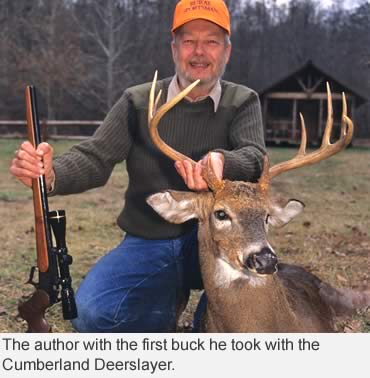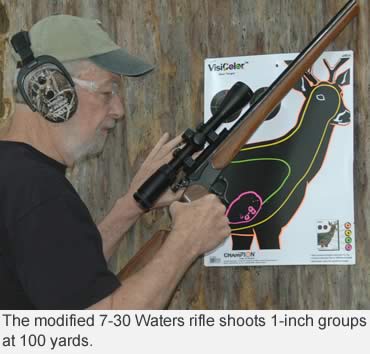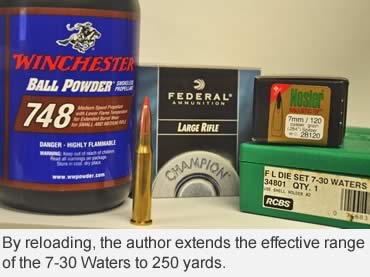DIY Cumberland Deerslayer
By J. Wayne Fears
You, too, can put together a special rifle for the area you hunt.
Photo: The author’s Cumberland Deerslayer was designed for tough mountain hunting in the Southeast.
It was the hike from hell. To get into the mountainous fold of land so the wind would be in my favor required me to go straight up a bluff thick with cedar and limestone boulders. Then I had to slide down a steep hillside thick with cedars, briars and rocks.
The stand I’d selected was in a rocky crevice. It overlooks a large white oak covered basin where three hollows come together. Once settled in the rock stand, I glanced down at the little G2 Contender rifle I had assembled just for hunting in the Cumberland Mountains.
Within an hour, a large 9-point buck came to the low grunts I made, and the 7-30 Waters handload I had developed for this semi-custom rifle took the buck cleanly at just under 200 yards.
Following that first hunt, I named the rifle the Cumberland Deerslayer. Since then, the little gun has taken many deer in Kentucky, Tennessee and Alabama.
To say the Cumberland Deerslayer is a custom rifle is not correct, for it isn’t. It is a rifle I assembled to hunt a specific region using aftermarket parts.
A few friends helped me assemble the short rifle perfect for the area I love to hunt. Any hunter can do the same.
 What You’ll Need
What You’ll Need
To take an existing rifle and modify it to meet your special hunting conditions requires you to evaluate what those special conditions are and what’s required to meet them. Perhaps you already have a rifle that, with a few modifications, will do the job nicely. Here is how I did it:
The Cumberland Mountains are steep, rocky, and extremely thick in many places. Lots of steep walking is required, so I wanted a compact, lightweight rifle.
Because of the thick cover, getting a second shot is rarely an option. I knew a single-shot rifle would do the job, and the short action would reduce the rifle’s overall length. I like to stalk hunt, so I wanted a well balanced rifle for offhand shooting and shooting from hasty rests.
Most shots in this mountainous terrain are short, usually under 100 yards. Occasionally a whitetail will appear in open hardwoods or along a power line right-of-way that may be out to 250 yards, so I wanted a proven caliber with the reloading capability to be accurate out to that distance.
 I also wanted a caliber with mild recoil and muzzle report, and one with the following specifications:
I also wanted a caliber with mild recoil and muzzle report, and one with the following specifications:
Caliber: 7-30 Waters
Action: Single shot
Barrel Length: 21 inches
Stock/forearm: Full Mannlicher style to balance rifle
Trigger: Smooth, creep-free, 5 pounds or under
Carry: Strong sling swivel studs
Lightweight: Under 6 pounds, without scope
Compact: Overall length under 36 inches
Selecting the Basic Rifle
I started my search for the basic rifle from which to work. In my gun safe I had a single-shot T/C G2 Contender rifle with a 23-inch .223 Rem barrel on it. I decided to use that for my base rifle as it has the trigger I wanted and weighs only 5.4 pounds. It was easy to change the barrel from .223 to 7-30 Waters. With the new barrel, the overall length would be just 35 inches.
My first step was to order a 21-inch barrel without open sights in 7-30 Waters caliber from the T/C Custom Shop. It was important to have an anchor hole drilled into the upper end of the barrel, 8 inches from the muzzle, for the upper sling swivel stud to go through the thin wood of the Mannlicher-style forearm and anchor into the barrel. The custom shop said they could do it.
While waiting for the barrel, I designed a Mannlicher-style forearm. It used the same forearm attachment hardware that was on the .223 Rem short forearm.
A friend who was a hobby wood craftsman made the new forearm from walnut. I wanted the forearm to match the separate walnut stock. When he completed the forearm, I took it to a local church woodworking group that finished the forearm to match the stock.
 Assembling the Rifle
Assembling the Rifle
The 7-30 Waters barrel arrived soon after I received the finished forearm, and I assembled the rifle. It was a compact, lightweight beauty.
For scope mounting, I attached a Weaver rail and a hammer extension to make cocking the rifle easier for my arthritic thumb. A leather sling was added, and a Nikon Buckmasters 3-9x40 scope now sits on the Cumberland Deerslayer.
At the range, the little rifle shoots 1-inch five-shot group at 100 yards with Federal factory loads, and I have worked up handloads that makes the rifle deadly on big bucks out to 250 yards.
The rifle has served me well in the rough terrain I hunt. It has taken a number of bucks, plus a much larger number of does. So if you have an area you like to hunt, assemble a special rifle for it. You will take pride in hunting with your own creation.
Read Recent GunHunter Articles:
• The Knockdown Power Myth: Bullet placement is far more important in the field than bullet theory.
• The Amazing .375 H&H Family: Dozens of rounds have been carved from H&H’s magnum opus.
This article was first printed in the December 2011 edition of Buckmasters GunHunter Magazine. Subscribe today to have GunHunter delivered to your home.